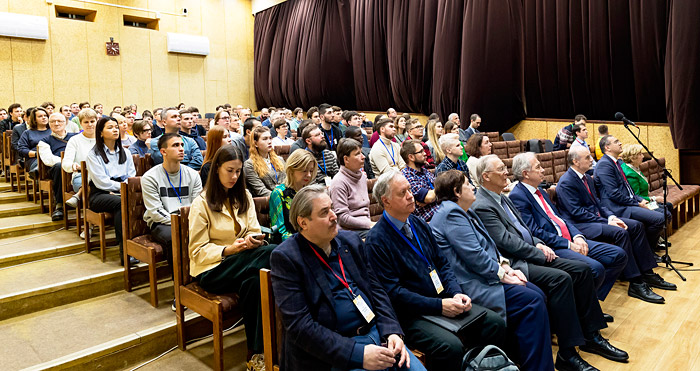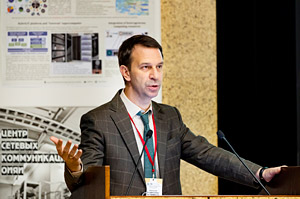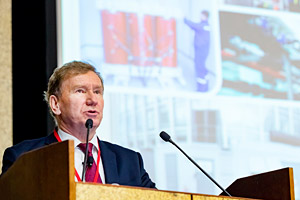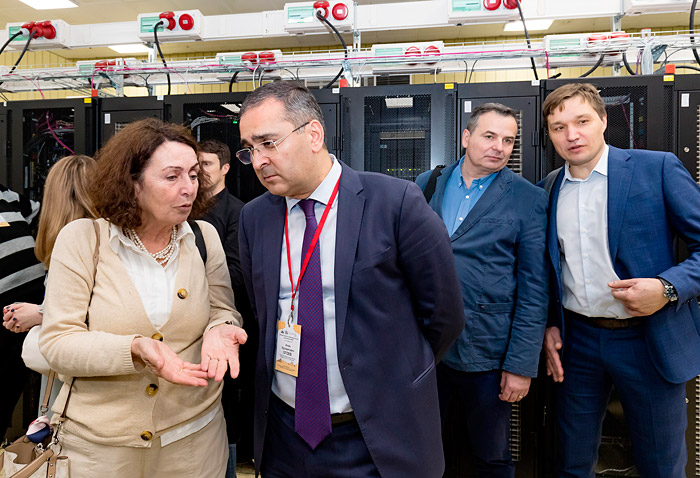
Electronic english version since 2022 |
The newspaper was founded in November 1957
| |
|
Number 47 (4644) |
Youth and science
At the Autumn School of Information Technologies
From 14 to 19 November, the JINR Autumn School of Information Technologies was held at the Laboratory of Information Technologies. Senior students from 13 universities of Russia learnt about the scientific programme of the Joint Institute, current developments in the field of distributed and high-performance computing for solving problems at the NICA accelerator complex and the JINR neutrino programme; machine learning and artificial intelligence for solving applied programmes and scientific problems of JINR; mathematical simulation, numerical methods and algorithms for solving applied problems of the Institute; current techniques and technologies of data processing and analysis.

Before the opening of the School, MLIT Director Vladimir Korenkov addressed the Institute's media representatives with the following words:
- Today, we are opening our IT School. Despite the fact that we have held a lot of similar schools, this one is special. We would like students from different universities who come to us to do final Bachelor's and Master's theses on our topics to cooperate with us after they have left. We hope that many of them will cast in lot with JINR or will be our collaborators in their regions, participants of the whole process. The programme of the School is very diverse: in addition to the traditional information areas that we have always developed, there will be a Multifunctional Information and Computing Complex, computing for megascience projects, new areas - machine learning and deep learning. Currently, we also work very extensively on the JINR Digital Ecosystem project that will also be discussed. For us, this is the most significant project that unites various information and functional systems that are aimed at the scientific, organizational, administrative and general service activities of our Institute. This is a kind of analogue of the JINR State Services, but much broader. One of the most essential digital areas is computing and collaboration support at NICA.
 "I am very glad to welcome here our friends and partners from Moscow State University, St. Petersburg University, Vladikavkaz and many other ones," JINR Director Grigory Trubnikov started his report "JINR Development Strategy". "I am glad that you have taken your best students, graduate students and teachers to us. We do not aim to lure them away. This is a process of mutual enrichment. We have a unique infrastructure, a unique scientific environment, a team in which the best thing for a young specialist is to make new contacts, to gain competencies for future self-realization. If you do this in your home universities - it will be doubly wonderful!"
"I am very glad to welcome here our friends and partners from Moscow State University, St. Petersburg University, Vladikavkaz and many other ones," JINR Director Grigory Trubnikov started his report "JINR Development Strategy". "I am glad that you have taken your best students, graduate students and teachers to us. We do not aim to lure them away. This is a process of mutual enrichment. We have a unique infrastructure, a unique scientific environment, a team in which the best thing for a young specialist is to make new contacts, to gain competencies for future self-realization. If you do this in your home universities - it will be doubly wonderful!"
Further, the speaker dwelled on the results and plans - what the Institute aims to do in the next seven years and in what state it is approaching the new seven-year period:
- So, how do we end 2022 and start 2023? JINR starts commissioning the project "NICA Complex", international research starts; the Superheavy Element Factory operates in a "cruising" mode, exceeding the capabilities of the previous FLNR complex and its competitors by dozens of times; The Baikal Deep-Underwater Neutrino Telescope is becoming a full-fledged part of the global network of large-scale neutrino detectors; the IT cluster ranks first in Russia and in Member States in terms of data storage capacity, data transmission rate and processing efficiency; The Joint Institute is one of the world's leading centres in the field of the use of neutron sources; the international programme of life sciences and innovative research at JINR has been fully launched.
The strategy for the development of information technologies at JINR involves the development of a unique heterogeneous cluster; one of the basic tasks is to build a grid system and Tier0 centre for the future NICA project (three backbones in experiments in high energy physics - accelerators, detectors, computing); quantum computing and algorithms in solving scientific problems should be extensively implemented. Grigory Trubnikov described the project of the digital platform "JINR Digital Ecosystem" as very interesting that unites current services and services of the future. The project involves the digitalization of not only scientific processes, but also administrative ones, as well as public and social activities. In fact, this is the development of its own operating system, to which later, if needed, one can add any applications. The project uses modern big data and artificial intelligence technologies.
 Vladimir Korenkov started his report by mentioning the great and glorious traditions of the Laboratory, established 56 years ago by its founders M.G.Meshcheryakov and N.N.Govorun, later he briefly spoke about the areas of the Laboratory. Engineering infrastructure widely develops in MLIT; much attention is paid to the network infrastructure - both the local network and external communications, the annual traffic is almost half of all scientific and educational traffic in Russia. The core of the IT infrastructure is the Multifunctional Information and Computing Complex, the main advantage of which is that it unites subsystems of different classes into one environment: Tier1 and Tier2 grid centres, cloud infrastructure, the Govorun supercomputer and a significant part is the data lake. Cloud infrastructure develops intensively, MLIT helps Member States and Russian research centres to organize their infrastructure - clouds have already been created in Azerbaijan, Belarus, Bulgaria, Egypt, Kazakhstan and will appear in Armenia and Georgia by the end of the year.
Vladimir Korenkov started his report by mentioning the great and glorious traditions of the Laboratory, established 56 years ago by its founders M.G.Meshcheryakov and N.N.Govorun, later he briefly spoke about the areas of the Laboratory. Engineering infrastructure widely develops in MLIT; much attention is paid to the network infrastructure - both the local network and external communications, the annual traffic is almost half of all scientific and educational traffic in Russia. The core of the IT infrastructure is the Multifunctional Information and Computing Complex, the main advantage of which is that it unites subsystems of different classes into one environment: Tier1 and Tier2 grid centres, cloud infrastructure, the Govorun supercomputer and a significant part is the data lake. Cloud infrastructure develops intensively, MLIT helps Member States and Russian research centres to organize their infrastructure - clouds have already been created in Azerbaijan, Belarus, Bulgaria, Egypt, Kazakhstan and will appear in Armenia and Georgia by the end of the year.
The Govorun supercomputer has already gone through two stages of modernization in 2018 and 2019, as a result of which its power and most importantly, memory have increased - it is focused on processing big data. Today, 25 percent of its users are from VBLHEP, 21 percent are from research centres in Russia and other Member States and the rest of the users are employees of all Laboratories of the Institute. Vladimir Korenkov spoke about the supercomputer infrastructure developed jointly with ISC (Interdepartmental Supercomputer Center) RAS and St. Petersburg Polytechnic University, the organization of efficient data storage, the development of current techniques and algorithms for working with data and other areas of development of the Laboratory.
Corresponding Member of the Russian Academy of Sciences Vladimir Voevodin (Research Computing Center, MSU), General Director of the RSK Group Alexander Moskovsky, Corresponding Member of the Russian Academy of Sciences Ruslan Smelyansky (Applied Research Center for Computer Networks), leading staff members of the Institute's Laboratories delivered their reports at the School.
The Rector of the North Ossetian State University Alan Ogoev was present at the opening of the School:
- Very close cooperation with the Joint Institute started almost five years ago in two areas: first, we cooperated with BLTP and a year later, MLIT joined the cooperation. It is very interesting that our university that opened the first JINR Information Centre on its site, fit into research both in these areas and in cloud technologies. I think that today students of all faculties - the Faculty of Chemistry, Biology and Biotechnology, Mathematics and Computer Science, Physical and Technical Sciences actually participate in internships for students and teachers, in the JINR JEMS programme. It is very important that the Joint Institute has become a central platform where both teachers and students practice, do internships and are involved in modern scientific research that is relevant not only for our country, but also for the world community. I think that as many students as possible should come here. On our platform, we actually unite the entire North Caucasian Federal District, so our students have the opportunity to get involved in this agenda through remote technologies. And in terms of content, the results that will be presented at this School and at the Schools that were previously held at our site and there were already four of them, I think, speak for themselves.
- Are students interested in the research carried out at JINR, or is it too early to talk about it?
- No, not early, they are already involved in this process. Students that study at the North Ossetian State University and young scientists that work there are involved in these investigations as part of their internship. In particular, they develop sensors for the NICA project. We participate actively in all research areas of JINR, including the investigation of environmental pollution by heavy metals.

N.E.Pukhaeva and A.U.Ogoev in the hall of the Govorun supercomputer.
Director of the JINR Information Center at NOSU and VBLHEP Senior researcher Nelli Pukhaeva added to the Rector: We participate in the MPD and FLAP collaborations in applied research. If we talk about the Information Center, we have our own concept: it has a scientific laboratory that develops prototypes for the MPD time-projection chamber, we will develop its database, test the cooling system and we have provided a high-voltage power supply. Here is such an activity in addition to the physical tasks that we plan in this area. The group is small and the university is small but we cooperate with all universities in the region - Kabarda, Chechnya, Stavropol, Rostov-on-Don and they also participate in all our events. We are soon going to hold a School under the NICA project to give basic knowledge of nuclear physics, a workshop that we have developed based on the film material of our bubble chambers.
(End in the next issues.)
Olga TARANTINA,
photo by Elena PUZYNINA